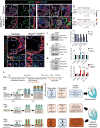Nrg1 Regulates Cardiomyocyte Migration and Cell Cycle in Ventricular Development
- PMID: 37846569
- PMCID: PMC10631509
- DOI: 10.1161/CIRCRESAHA.123.323321
Nrg1 Regulates Cardiomyocyte Migration and Cell Cycle in Ventricular Development
Abstract
Background: Cardiac ventricles provide the contractile force of the beating heart throughout life. How the primitive endocardium-layered myocardial projections called trabeculae form and mature into the adult ventricles is of great interest for biology and regenerative medicine. Trabeculation is dependent on the signaling protein Nrg1 (neuregulin-1). However, the mechanism of action of Nrg1 and its role in ventricular wall maturation are poorly understood.
Methods: We investigated the functions and downstream mechanisms of Nrg1 signaling during ventricular chamber development using confocal imaging, transcriptomics, and biochemical approaches in mice with cardiac-specific inactivation or overexpression of Nrg1.
Results: Analysis of cardiac-specific Nrg1 mutant mice showed that the transcriptional program underlying cardiomyocyte-oriented cell division and trabeculae formation depends on endocardial Nrg1 to myocardial ErbB2 (erb-b2 receptor tyrosine kinase 2) signaling and phospho-Erk (phosphorylated extracellular signal-regulated kinase; pErk) activation. Early endothelial loss of Nrg1 and reduced pErk activation diminished cardiomyocyte Pard3 and Crumbs2 (Crumbs Cell Polarity Complex Component 2) protein and altered cytoskeletal gene expression and organization. These alterations are associated with abnormal gene expression related to mitotic spindle organization and a shift in cardiomyocyte division orientation. Nrg1 is crucial for trabecular growth and ventricular wall thickening by regulating an epithelial-to-mesenchymal transition-like process in cardiomyocytes involving migration, adhesion, cytoskeletal actin turnover, and timely progression through the cell cycle G2/M phase. Ectopic cardiac Nrg1 overexpression and high pErk signaling caused S-phase arrest, sustained high epithelial-to-mesenchymal transition-like gene expression, and prolonged trabeculation, blocking compact myocardium maturation. Myocardial trabecular patterning alterations resulting from above- or below-normal Nrg1-dependent pErk activation were concomitant with sarcomere actin cytoskeleton disorganization. The Nrg1 loss- and gain-of-function transcriptomes were enriched for Yap1 (yes-associated protein-1) gene signatures, identifying Yap1 as a potential downstream effector. Furthermore, biochemical and imaging data reveal that Nrg1 influences pErk activation and Yap1 nuclear-cytoplasmic distribution during trabeculation.
Conclusions: These data establish the Nrg1-ErbB2/ErbB4-Erk axis as a crucial regulator of cardiomyocyte cell cycle progression and migration during ventricular development.
Keywords: actin cytoskeleton; actins; cell cycle; endocardium; myocardium; sarcomeres.
Conflict of interest statement
Figures





References
-
- Jimenez-Amilburu V, Rasouli SJ, Staudt DW, Nakajima H, Chiba A, Mochizuki N, Stainier DY. In vivo visualization of cardiomyocyte apicobasal polarity reveals epithelial to mesenchymal-like transition during cardiac trabeculation. Cell Rep. 2016;17:2687–2699. doi: 10.1016/j.celrep.2016.11.023 - PubMed
-
- Li J, Miao L, Shieh D, Spiotto E, Li J, Zhou B, Paul A, Schwartz RJ, Firulli AB, Singer HA, et al. Single-cell lineage tracing reveals that oriented cell division contributes to trabecular morphogenesis and regional specification. Cell Rep. 2016;15:158–170. doi: 10.1016/j.celrep.2016.03.012 - PMC - PubMed
-
- Meyer D, Birchmeier C. Multiple essential functions of neuregulin in development. Nature. 1995;378:386–390. doi: 10.1038/378386a0 - PubMed
Publication types
MeSH terms
Substances
LinkOut - more resources
Full Text Sources
Molecular Biology Databases
Research Materials
Miscellaneous

